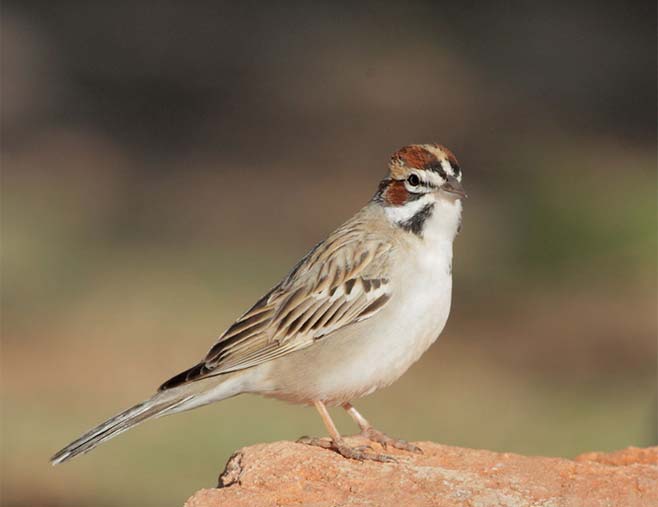 |
Lark Sparrow
Chondestes grammacus |
|
|
STANFORD LOCATIONS: |
 |
Location |
Type |
Mating System |
Parental Care |
2ndary Diet |
Strategy |
|
|
|
|
I: 11-12 DAYS ALTRICIAL |
|
|
|
0 - 7 feet (To 25 feet |
|
MONOG (POLYGYN) |
MF |
|
| BREEDING: | Grassland, prairie, savanna, cultivated areas, fields with scattered trees and shrubs. 1 brood. |
| DISPLAYS: | Courtship: male struts before female with bill pointed up, tail spread, wings fluttering; flight song on rapidly beating wings with spread tail. Twig often held by female or passed to her during cop. |
| NEST: | Often hollow depression in ground lined with fine grass; nest in shrub or rock crevice bulky, of grass, forbs, foundation of twigs, lined with fine materials. Often reuse their own nests and those of other species (esp mockingbird and thrashers). Male and female select site together. |
| EGGS: | Creamy to grayish-white, marked with dark browns, blacks, often wreathed. 0.8" (20 mm). |
| DIET: | Includes grass and forb seeds. |
| CONSERVATION: | Winters s to c Mexico. Occ cowbird host. |
| NOTES: | Gregarious, feeding in flocks even in breeding season. Weak territoriality disappears entirely when incubation begins. Male often presents food to female on nest and she feeds nestlings. Distraction display by ground-nesting female: spreads tail and flutters one or both wings. Male often sings at night. |
| ESSAYS: | Distraction Displays; Vocal Functions. |
| REFERENCES: | McNair, 1984. |
| Help | Abbreviations | Species-Alphabetical | Species-Taxonomic | Essays-Alphabetical | |
| Except for Stanford Locations, the material in this species treatment is taken, with permission, from The Birder's Handbook (Paul Ehrlich, David Dobkin, & Darryl Wheye, Simon & Schuster, NY. 1988). | |||||